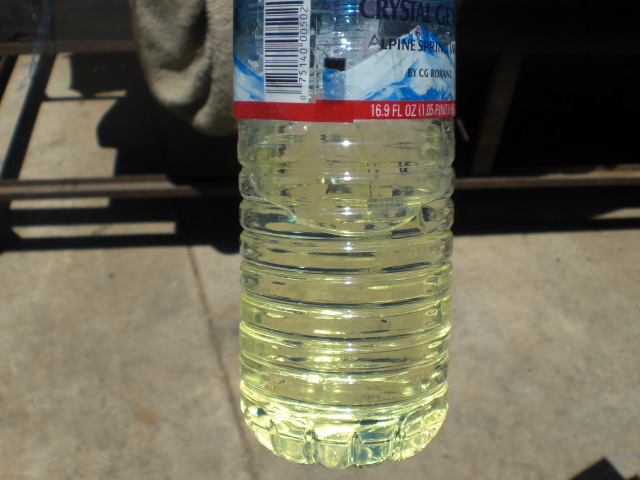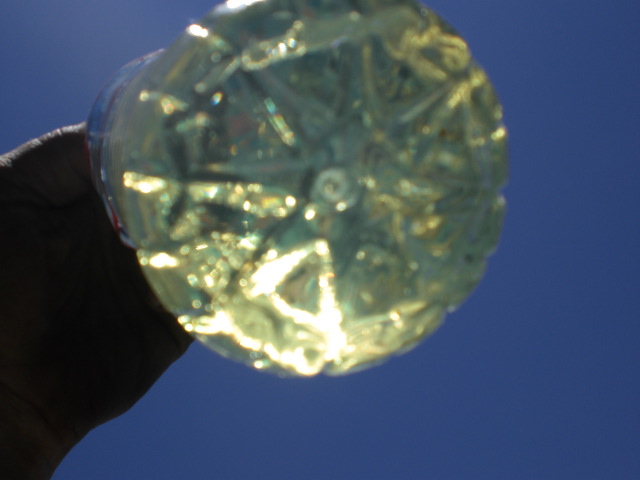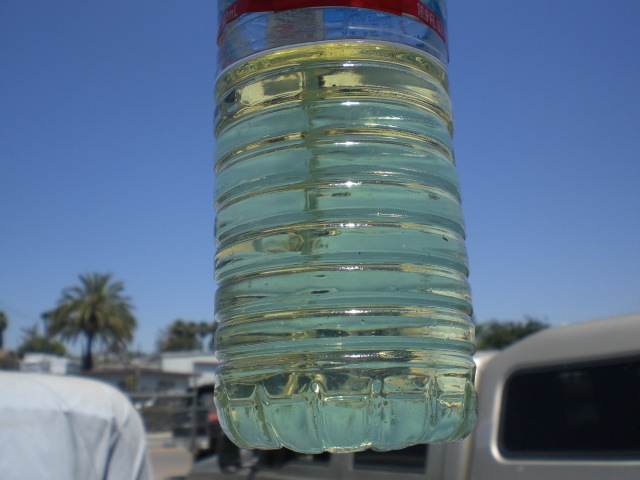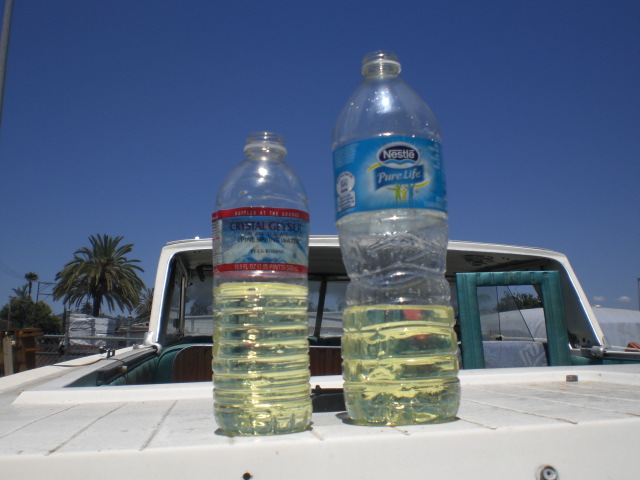Any Creative Ideas for LEGALLY Disposing of Old Diesel Fuel...
#17
Ok so I learned there is not an anti siphon device installed on this thing. I also learned that old diesel tastes a tad bit better than brand new diesel but still smells exactly the same. I learned that old diesel looks very much like Pee after drinking one Mountain Dew and actually maybe slightly clearer. I see nothing here that I can filter at all. Im not sure of the color of color of fresh diesel but I have a little so I think I will take the time to compare. These pics are of what I just siphoned out of the old diesel... very clear, just a trace of yellow / Green color.



EDIT
This is fresh diesel in the larger bottle. Smells slightly stronger but other than that its looks the same! Think this stuff will slide right through those injectors! I bet The PO used that Octane Booster or something as it appears he was intune to this stuff.

EDIT
This is fresh diesel in the larger bottle. Smells slightly stronger but other than that its looks the same! Think this stuff will slide right through those injectors! I bet The PO used that Octane Booster or something as it appears he was intune to this stuff.
#18
One of the things to watch for is algae, it will grow in diesel fuel, there are biocides made for treatment. Water contamination is sort of the same thing, that's how the critters get in there to begin with I think.
It's hard to tell because of the plastic but it looks clear? No cloudiness or separation? I'd be inclined to run it. Diesel is just a different animal than gasoline.
It's hard to tell because of the plastic but it looks clear? No cloudiness or separation? I'd be inclined to run it. Diesel is just a different animal than gasoline.
#19
Mmm, looks good to me. Get a paint strainer to filter the fuel if you're worried about it. The new filter you add will take care of the rest. If anything, mix it back in slowly with new fuel.
I "drained" my tank (the gauge read about a quarter when I did this, stock 38 gal useable) by running a line from the fuel filter drain line into a 10 gallon diesel jug and cycling the fuel pump. I filled the jug and had to drop the tank with whatever was left in it. It was still pretty damn heavy. Putting it back up after the Hutch / Harpoon mods was a PITA by myself and two floor jacks. Those mods gave me about 8 gals of extra fuel capacity. I haven't run it dry since, but I can let it go below the "E" and get 39-40 gals in every time. Never got more than 32-33 in it before. 650 combined miles on a tank now.
Pull the bed, it'll make it easier to install the Racor filter, not lying on your back. You'll probably find a few other things you'll want to do anyway, rust repair, brake hose / lines, etc. Or at least wash the back of the cab!
I "drained" my tank (the gauge read about a quarter when I did this, stock 38 gal useable) by running a line from the fuel filter drain line into a 10 gallon diesel jug and cycling the fuel pump. I filled the jug and had to drop the tank with whatever was left in it. It was still pretty damn heavy. Putting it back up after the Hutch / Harpoon mods was a PITA by myself and two floor jacks. Those mods gave me about 8 gals of extra fuel capacity. I haven't run it dry since, but I can let it go below the "E" and get 39-40 gals in every time. Never got more than 32-33 in it before. 650 combined miles on a tank now.
Pull the bed, it'll make it easier to install the Racor filter, not lying on your back. You'll probably find a few other things you'll want to do anyway, rust repair, brake hose / lines, etc. Or at least wash the back of the cab!
#20
Let the sample sit for a day to see if any small globules of water settle out of it.
Clearly, the sample isn't cloudy. Nor does it appear to be a petri dish for algae bloom.
A previous poster said to treat the fuel and run it in small batches mixed with new fuel. That's what I would do. Keep in mind, due to stricter regulations, California diesel is refined better than diesel nationwide. That is one reason (or official sounding excuse) why Californian's pay better than a dollar more per gallon than elsewhere. California was pumping low sulphur fuel for at least 18 months prior to the rest of the nation. Heck, it might even be good enough to drink... but it sounds like you've already tried it.
The most responsible way to dispose of it is to use it as intended... for fuel. Dilute it in with larger batches of new fuel, and your 7.3L engine will be none the wiser. The advice would be quite different if you had a new 6.7L engine with the super sensitive and costly CP4 pump and fuel system. People who built expedition campers based on the Ford 6.7L cab chassis found that they couldn't even use NEW fuel sold in Mexico, without incurring five figure engine and fuel system repair bills. The irony is, that the 6.7L is built in Mexico, yet can't run the fuel sold in Mexico.
That's why your friend's neighbors converged on you like crabs in a barrel when you showed up to haul what they have been eyeing for years away from their claw's futile clasps. The 7.3L can run on kerosene, jet fuel, Mexican fuel, bio diesel (not just B20), waste vegetable oil, waste motor oil (centrifuged, filtered, and diluted), as well as old diesel.
Racor makes a product called BioCide that is for treating and preventing algae. A shock treatment can be applied to your remaining fuel, and as long as you run Racor filters (stock oem Motorcraft) the chemicals should not weaken the filter membrane.
You aren't afraid to ask really great questions, and I furthermore admire your cautious approach. You've been a great addition to this club.
If I said anything redundant, it is because the guys above type faster.
Clearly, the sample isn't cloudy. Nor does it appear to be a petri dish for algae bloom.
A previous poster said to treat the fuel and run it in small batches mixed with new fuel. That's what I would do. Keep in mind, due to stricter regulations, California diesel is refined better than diesel nationwide. That is one reason (or official sounding excuse) why Californian's pay better than a dollar more per gallon than elsewhere. California was pumping low sulphur fuel for at least 18 months prior to the rest of the nation. Heck, it might even be good enough to drink... but it sounds like you've already tried it.
The most responsible way to dispose of it is to use it as intended... for fuel. Dilute it in with larger batches of new fuel, and your 7.3L engine will be none the wiser. The advice would be quite different if you had a new 6.7L engine with the super sensitive and costly CP4 pump and fuel system. People who built expedition campers based on the Ford 6.7L cab chassis found that they couldn't even use NEW fuel sold in Mexico, without incurring five figure engine and fuel system repair bills. The irony is, that the 6.7L is built in Mexico, yet can't run the fuel sold in Mexico.
That's why your friend's neighbors converged on you like crabs in a barrel when you showed up to haul what they have been eyeing for years away from their claw's futile clasps. The 7.3L can run on kerosene, jet fuel, Mexican fuel, bio diesel (not just B20), waste vegetable oil, waste motor oil (centrifuged, filtered, and diluted), as well as old diesel.
Racor makes a product called BioCide that is for treating and preventing algae. A shock treatment can be applied to your remaining fuel, and as long as you run Racor filters (stock oem Motorcraft) the chemicals should not weaken the filter membrane.
You aren't afraid to ask really great questions, and I furthermore admire your cautious approach. You've been a great addition to this club.
If I said anything redundant, it is because the guys above type faster.
#21
We want CETANE improver in our diesels, but in California it generally isn't needed. CETANE improver doesn't make diesel store better or last longer... it just helps it run better.
There are other additives, like Racor BioCide, and other products from Ford and from Stanadyne, that keep fuel from gelling (not a problem for you in San Diego) and increase the lubricity of fuel (that is lost from reducing the sulpher content of the fuel in the refining process).
You don't want Octane booster. And you don't want any fuel additive that has alcohols in it.
#22
That diesel looks pretty good to me too, my biggest concern was algae build up, which from the sample you showed doesn't really seem to be an issue here. If it were me I would dilute it with some fresh diesel and run it, the tolerances on these 7.3's on the quality of the fuel is not as high as a modern diesel. Looks like you have one thing scratched off your list!
#23
Let the sample sit for a day to see if any small globules of water settle out of it.
Clearly, the sample isn't cloudy. Nor does it appear to be a petri dish for algae bloom.
A previous poster said to treat the fuel and run it in small batches mixed with new fuel. That's what I would do. Keep in mind, due to stricter regulations, California diesel is refined better than diesel nationwide. That is one reason (or official sounding excuse) why Californian's pay better than a dollar more per gallon than elsewhere. California was pumping low sulphur fuel for at least 18 months prior to the rest of the nation. Heck, it might even be good enough to drink... but it sounds like you've already tried it.
The most responsible way to dispose of it is to use it as intended... for fuel. Dilute it in with larger batches of new fuel, and your 7.3L engine will be none the wiser. The advice would be quite different if you had a new 6.7L engine with the super sensitive and costly CP4 pump and fuel system. People who built expedition campers based on the Ford 6.7L cab chassis found that they couldn't even use NEW fuel sold in Mexico, without incurring five figure engine and fuel system repair bills. The irony is, that the 6.7L is built in Mexico, yet can't run the fuel sold in Mexico.
That's why your friend's neighbors converged on you like crabs in a barrel when you showed up to haul what they have been eyeing for years away from their claw's futile clasps. The 7.3L can run on kerosene, jet fuel, Mexican fuel, bio diesel (not just B20), waste vegetable oil, waste motor oil (centrifuged, filtered, and diluted), as well as old diesel.
Racor makes a product called BioCide that is for treating and preventing algae. A shock treatment can be applied to your remaining fuel, and as long as you run Racor filters (stock oem Motorcraft) the chemicals should not weaken the filter membrane.
You aren't afraid to ask really great questions, and I furthermore admire your cautious approach. You've been a great addition to this club.
If I said anything redundant, it is because the guys above type faster.
Clearly, the sample isn't cloudy. Nor does it appear to be a petri dish for algae bloom.
A previous poster said to treat the fuel and run it in small batches mixed with new fuel. That's what I would do. Keep in mind, due to stricter regulations, California diesel is refined better than diesel nationwide. That is one reason (or official sounding excuse) why Californian's pay better than a dollar more per gallon than elsewhere. California was pumping low sulphur fuel for at least 18 months prior to the rest of the nation. Heck, it might even be good enough to drink... but it sounds like you've already tried it.
The most responsible way to dispose of it is to use it as intended... for fuel. Dilute it in with larger batches of new fuel, and your 7.3L engine will be none the wiser. The advice would be quite different if you had a new 6.7L engine with the super sensitive and costly CP4 pump and fuel system. People who built expedition campers based on the Ford 6.7L cab chassis found that they couldn't even use NEW fuel sold in Mexico, without incurring five figure engine and fuel system repair bills. The irony is, that the 6.7L is built in Mexico, yet can't run the fuel sold in Mexico.
That's why your friend's neighbors converged on you like crabs in a barrel when you showed up to haul what they have been eyeing for years away from their claw's futile clasps. The 7.3L can run on kerosene, jet fuel, Mexican fuel, bio diesel (not just B20), waste vegetable oil, waste motor oil (centrifuged, filtered, and diluted), as well as old diesel.
Racor makes a product called BioCide that is for treating and preventing algae. A shock treatment can be applied to your remaining fuel, and as long as you run Racor filters (stock oem Motorcraft) the chemicals should not weaken the filter membrane.
You aren't afraid to ask really great questions, and I furthermore admire your cautious approach. You've been a great addition to this club.
If I said anything redundant, it is because the guys above type faster.
I truly appreciate the imparting of your knowledge and wisdom. Especially when considering I am a hunt and peck typist as well. Sometimes it just painful!
 The more I post and listen the more I am starting to appreciate what I truly have here.
The more I post and listen the more I am starting to appreciate what I truly have here. The Old Dodge was wonderful that I could pour veggie oil in it and just about anything else and she would never even burp. She was a 93 3500 and at her old age I didn't really care too much what I fed her. The exhaust got a bit noxious at times but at her age one must overlook some things. I was afraid that this 8 cylinder was so totally sophisticated that I could do more damage than good very easily. I was Spooked! I think I'm starting relax and I'm feeling more confidant with the help of your direction.
I'm thinking our consistent weather and temps. might help with the fuel longevity. I'm also guessing the PO probably poured in some type of preserver as he knew it would be sitting awhile? Just guessing though. I am kinda of curious to see what the filter looks like. I might, (((MIGHT))) not drop the tank right now. I'm Thinking I might drain the old and add a bit at a time and just see what happens. Worse case is clogging the injectors. and I doubt that is going to happen.
#25
Draining your fuel bowl (see your other thread for where the tube is) and removing your old fuel filter should be step number one, absolutely.
With the cap off (save it!) and the filter out, take a look at the bottom of the fuel bowl (on top of the motor) and see what has settled to the bottom, if anything.
Replace the filter with a genuine Motorcraft or Racor ParFit fuel filter, with a built in Aquablock pre filter, and without a built in cap. If your current filter comes out with the cap, then get the OEM replacement cap. Be sure and replace the bevel cut gasket as well. The new gasket comes with the new filter.
With the cap off (save it!) and the filter out, take a look at the bottom of the fuel bowl (on top of the motor) and see what has settled to the bottom, if anything.
Replace the filter with a genuine Motorcraft or Racor ParFit fuel filter, with a built in Aquablock pre filter, and without a built in cap. If your current filter comes out with the cap, then get the OEM replacement cap. Be sure and replace the bevel cut gasket as well. The new gasket comes with the new filter.
#29
One of the things to watch for is algae, it will grow in diesel fuel, there are biocides made for treatment. Water contamination is sort of the same thing, that's how the critters get in there to begin with I think.
It's hard to tell because of the plastic but it looks clear? No cloudiness or separation? I'd be inclined to run it. Diesel is just a different animal than gasoline.
It's hard to tell because of the plastic but it looks clear? No cloudiness or separation? I'd be inclined to run it. Diesel is just a different animal than gasoline.
#30
I say gather up and squeeze them little Fungi really tight, Stuff as many that will fit in a cylinder, I mean really cram them in there... and Blow um up! Spin their little ashes at high speed through a big arss tube and spit them out on the road! Think my little corner of the world will be a much happier and better place once this is accomplished! Gota deal with the riff raff or them Fungi will just take over!




